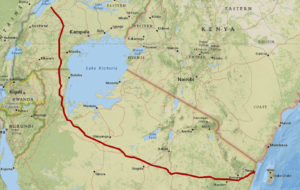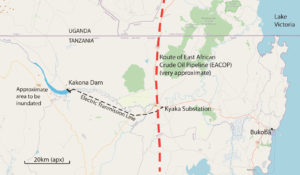by Ben Taylor
Controversial oil pipeline gets government approval
The government of Tanzania gave formal approval in February for the construction of the USD $3.5bn East African Crude Oil Pipeline (EACOP), despite human rights and environmental concerns around the project. This followed official approval for the project from the Ugandan government in January.
The 900-mile pipeline will transport crude from oilfields in Lake Albert in north-western Uganda to the port of Tanga on the Indian Ocean, passing not far from Singida and Kondoa [see TA 128]. The pipe will be 600mm diameter steel with heating to improve the fluidity of the oil, and will require a 30m wide corridor over the entire route (Eacop.com). The $10 billion oilfield and pipeline project is being jointly developed by France’s TotalEnergies, the China National Offshore Oil Corporation (CNOOC) and the state oil companies of Uganda and Tanzania. The first oil is expected to flow in 2025.
“This construction approval marks another step forward to EACOP as it allows commencement of the main construction activities in Tanzania, upon completion of the ongoing land access process,” said EACOP Tanzania general manager Wendy Brown.
The project has been hailed by some as an economic boon for both countries, though it has run into strong opposition from human rights and environmental campaigners, who say it threatens the region’s fragile ecosystem and the livelihoods of tens of thousands of people.
Tanzania’s Energy Minister, January Makamba, dismissed the environmental and rights concerns as “propaganda”, and said that all environmental, safety and human rights standards have been complied with. “We are proud of the pipeline because it will increase Tanzania’s influence in the world,” he added.
The oil originates in two oilfields on Lake Albert. Drilling began in January at the Kingfisher field on the south-eastern edge of the lake, operated by CNOOC, while the second field on the lake’s northern shore is being developed by TotalEnergies. This second field, known as Tilenga, extends into Uganda’s largest national park, Murchison Falls. At least 100 oil wells are reported to have been drilled inside the reserve.
There are an estimated 6.5 billion barrels of crude oil under the lake, of which a little over 20% is thought to be recoverable. The reserves are expected to last up to 30 years, with production peaking at 230,000 barrels a day. This would be sufficient to make Uganda the fourth-largest hydrocarbon producer in sub-Saharan Africa.
The pipeline has been controversial for the potential damage it could do to the environment and to people’s lives and livelihoods along the route. Fishers on Lake Albert are already seeing pollution on the lake, and one-third of EACOP will pass through the Lake Victoria watershed, on which an estimated 40 million people depend for their livelihood. “A leak along the pipeline could be a cataclysm,” said Hilda Flavia Nakabuye, a Ugandan activist, and “once consumed, the oil extracted will emit nearly 34m tonnes of CO2 a year, six times the emissions of Uganda”.
TotalEnergies is being sued in France by a group of NGOs for allegedly failing to comply with the country’s 2017 duty-of-care law. The NGOs are asking the Paris court to suspend TotalEnergies’ Ugandan projects, claiming the company is in breach of their legal obligation to identify and prevent human rights and environmental abuses resulting from its own activities or those of its subcontractors.
Civil society organisations in Uganda have also fought against the project, but have met with stiff resistance from the authorities. According to reports, the army now has a regular presence across the oil-producing region, journalists have been persecuted and human rights activists hindered in their work. Dickens Kamugisha of the Africa Institute for Energy Governance, a small NGO, explained that “the government passed a law in 2016 designed to hinder the activity of NGOs. The aim is to muzzle civil society”. Another activist, Maxwell Atuhura, is among those to have been arrested over EACOP. “The more I informed people, the more I was being watched,” he said. “It started with tailing, then negative blurb about me on the local radio, and finally an arrest in May 2021. I spent two nights in jail. The police confiscated all my equipment and threatened me, telling me that I was risking my life to continue my work.” (The Nation, The Guardian)
President Samia calls for attention on Africa in the energy transition
President Samia Suluhu Hassan has called for western governments and companies to focus on the needs of African countries when acting to address climate change and steering the global energy transition. She made the call in Davos, Switzerland, in January, on the sidelines of the annual World Economic Forum (WEF).
President Samia said it was high time developed countries in Europe and America put focus on producing energy from Africa, and that resources in Africa could help smooth the energy transition. “Africa could be another source of energy,” she said. “When it comes to green energy, we have almost everything ranging from nickel, cobalt and copper.”
She also reached out to private sector in developed countries to provide funding for Africa to enable the continent to produce more energy from natural gas. “It is true that we need energy transition but this should take some time, we also need funding to embark on energy transition,” Dr Samia appealed. She noted that there is high demand for energy in the African continent amid the fourth industrial revolution which is taking place across the globe.
Further, the President urged African countries to put more efforts in strengthening regional power pools such as East African and Southern Africa power pools, saying not enough has been done. “If we create these power pools there will be no problems of shortage of energy because whoever who will be having a crisis will be served by the regional power pools,” she remarked.
She reminded leaders during the discussion that the energy transition is a global problem which requires global solutions. “There is a need for a multilateral approach in addressing the challenge,” she said, and expressed her concerns that many developed countries are formulating energy strategy unilaterally rather than engaging developing countries.
Speaking late in 2022 at the United Nations Climate Change Conference (COP27) in Egypt, President Samia said Tanzania is taking a number of initiatives aimed at mitigating the impacts of climate change for sustainable development.
She said the government has adopted a national climate change response strategy and contribution with a target of reducing greenhouse gas emissions between 30 to 35 per cent by the year 2030. This includes continuing to construct and expand rapid transport networks. She explained that these are expected to reduce more than 900 million tonnes of carbon emissions each year. (Daily News)
Agreement reached for new hydropower project in Kagera
The government of Tanzania, the African Development Bank (AfDB), and the French Development Agency (AFD) have signed agreements for two development project loans worth a total of $300 million to finance the construction of the 88MW Kakono Hydropower Plant in Kagera region. The project also received a grant of 36 million Euros from the European Union (EU).
The project, to be implemented by the Electric Supply Company (TANESCO), will reportedly reduce greenhouse gas emissions by an estimated 216,065 metric tons per year and comply with highest international environmental and social standards. The government expects that the project will serve four million people and increase the service coverage rate by around 7% of the population.
Alongside the construction of the new hydropower plant, associated infrastructure will be built, including upgrading the existing Kyaka substation and a new 39-kilometre 220-kilovolt transmission line and capacity building support for TANESCO.
The French Ambassador to Tanzania Nabil Hajlaoui said: “We have heard President Samia Suluhu’s message. She aims to generate 5GW of electricity by 2025. France is ready to be part of this journey by investing in power generation and transmission projects to meet the rapidly growing electricity demand while reducing the carbon intensity of its energy mix.”
The concrete dam will be 51m in height above the river bed, creating a reservoir which will extend about 28km upstream of the dam, with a width of around 1.5km at the widest point. (AfDB)
Deals agreed with three Australian mining firms
President Samia Suluhu Hassan in April witnessed the signing of deals worth US$600 million with three different Australian companies as Tanzania seeks to gain more from its vast wealth of minerals.
During a function at the State House in Dodoma, the President witnessed her administration closing deals with Evolution Energy Minerals Limited, EcoGraf Limited and Peak Rare Earth Limited.
With EcoGraf Limited, Tanzania agreed to the development and operation of the Epanko Graphite Project in Morogoro. An initial investment worth US$127.7 million will be made. With Peak Rare Earths Limited, the government agreed to the development of the Ngualla Rare Earth Project with an initial investment of US$439 million. With Evolution Energy Minerals Limited, the Samia Administration agreed to the development of the Chilalo Graphite Project in Lindi with an initial investment worth US$100 million.



